Post-Impressionism is one of the most vivid art movements of the period between 1880 and 1905 which developed mainly in such European countries as France and England. Following the ideas of Impressionism, such painters as Paul Cezanne developed their unique vision of depicting emotions and impressions in a picture.
Paul Cezanne (1839–1906), the French artist, is often discussed as the founder of Post-Impressionism movement and its ideologist. The new approach to reflecting personal emotions can be observed with references to Cezanne’s paintings. Focusing on the personal vision of art, the artist developed the links between previous Impressionism and further Cubism (Medina).
That is why, the works by Cezanne are characterized by the extreme focusing on forms and colors in order to represent the author’s specific vision of the world. Thus, to understand the variety and depth of Cezanne’s paintings, it is necessary to concentrate on the most famous works of the artist.
In his works, Cezanne intended to demonstrate emotions and ideas which could be reflected in abstract artificial forms. The artists did not pay much attention to perspectives and to the relations between foreground and background because the main focus was on the meaning which often could be rather symbolic. The works by Cezanne are easily recognized because of the strict forms and contrasts (Medina).
To accentuate definite objects, the artist often used simple colors, but with developing a lot of tones. Furthermore, Cezanne effectively used the play of light.
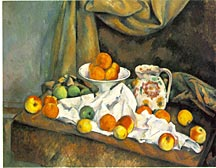
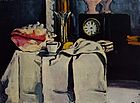
Compote, Pitcher and Fruit, 1892 The Black Marble Clock, 1869–1871
This approach helped draw the audience’s attention to the meaning of the paintings instead of presenting the natural objects in relation to their real forms and colors. From this point, Post-Impressionism is the art of emotions and deep ideas in which the depicted objects serve only for reflecting these ideas (Rabinow).

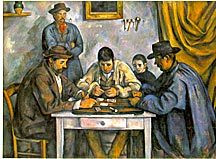
Woman Seated, in Blue, 1902 The Card Players, 1892
It seems that in his works, Cezanne did not differentiate between the approaches to depicting the humans, natural objects, or artificial objects. Bold multidirectional strokes are typical for all Cezanne’s paintings in spite of the object for depiction. From this point, it is interesting to pay attention to Cezanne’s depiction of the nature and landscapes.
The changes in the perspective and spaces are represented by the artist with the help of changing colors and contrasting the tones (Rabinow). Cezanne’s landscapes are intended to represent the artist’s emotions about them rather than the actual forms and spaces.
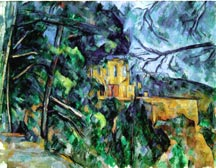
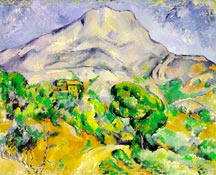
Chateau Noir, 1900 Mont Sainte Victoire, 1900
The works by many Post-Impressionists are discussed as independent and individual. Cezanne’s paintings are also incomparable with the works of the other artists because of the unique emotional brushwork and focus on abstractionism.
The artist developed the theory of art according to which only ideas and impressions with emotions can form the further art peace as the reflection of the author’s ideals (Medina). To emphasize the opposition between the ideal and naturalistic worlds, Cezanne used artificial strict and constructed forms and bold brushwork.

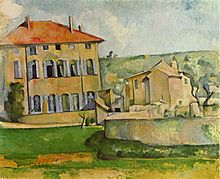
Les Grandes Baigneuses, 1898-1905 Jas de Bouffan, 1885–1887
Paul Cezanne is the unique artist whose works influenced the art perceptions of not only the representatives of Post-Impressionism because of the developed and applied theory or art but also the visions of the further artists who realized the ideas supported by Cezanne in Cubism and other movements associated with the abstract art.
Works Cited
Medina, Joyce. Cézanne and Modernism: The Poetics of Painting. USA: SUNY Press, 1995. Print.
Rabinow, Rebecca. Cézanne to Picasso. USA: Metropolitan Museum of Art, 2006. Print.